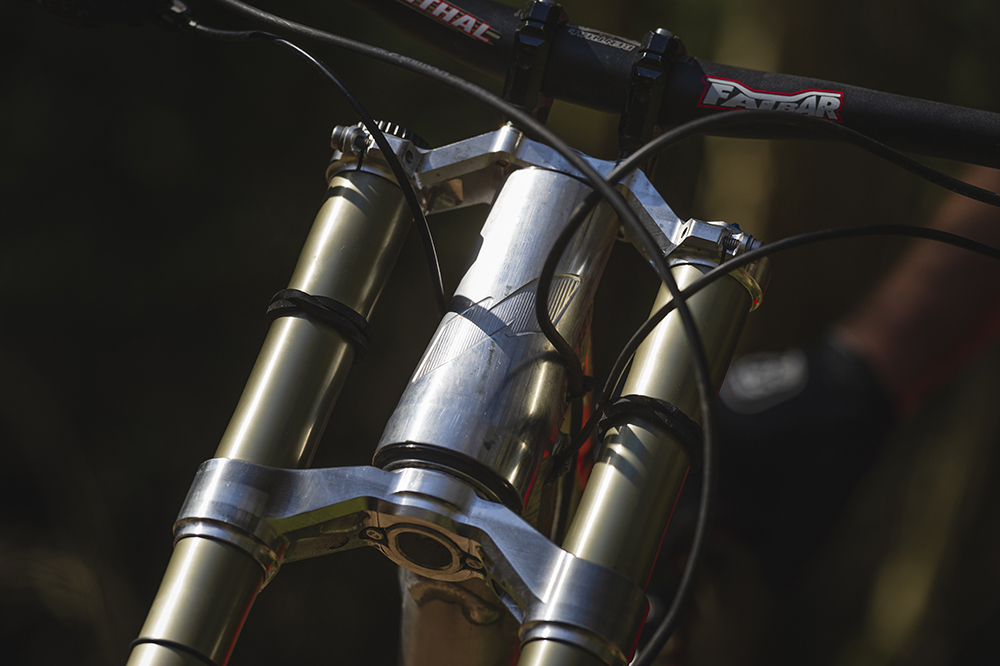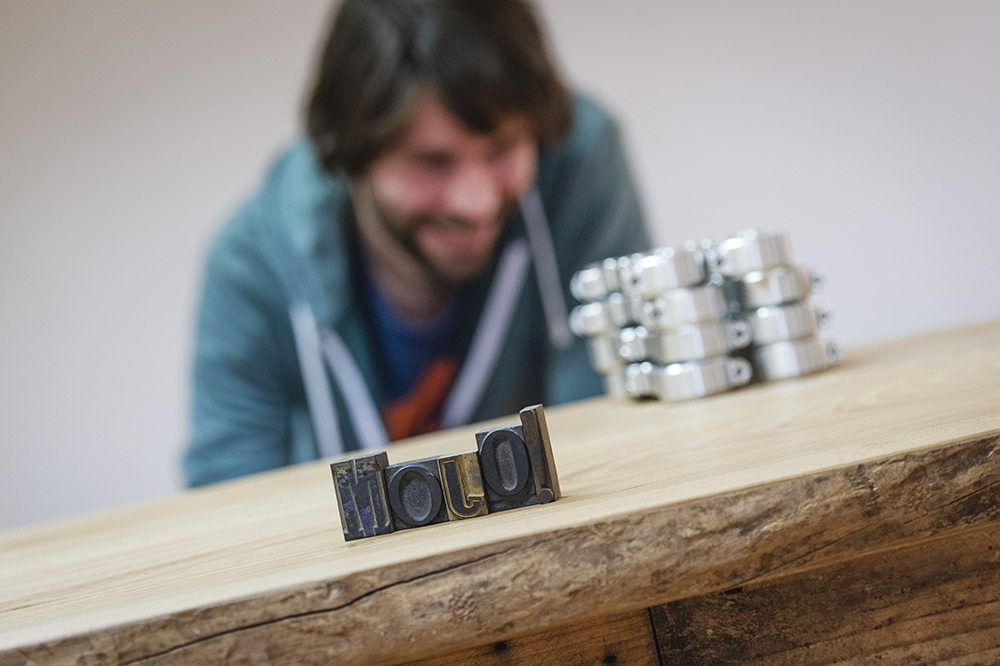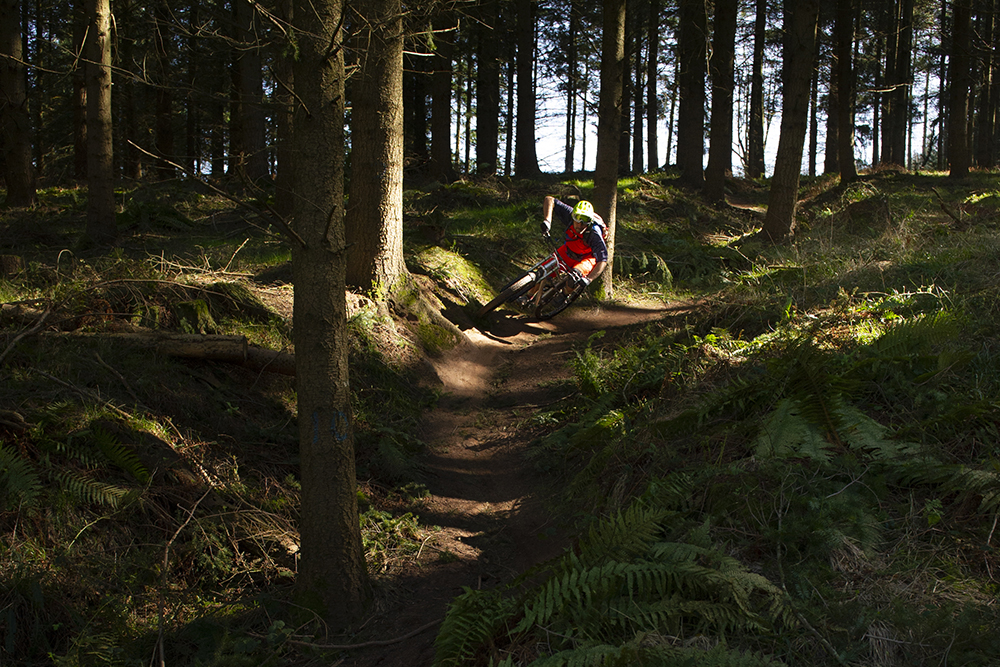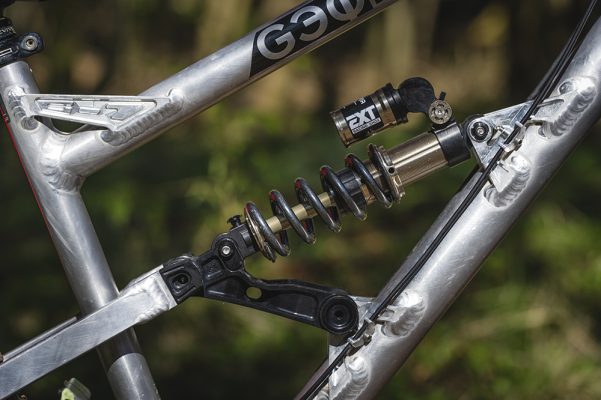Another in our new Best of British series. mbr turns up, tunes in and drops out with Chris Porter from Geometron.
‘Long, low and slack’ has become the mantra of mountain bike design thanks to a rule-bending visionary whose wayward imagination was honed by the Wye Valley.
Words & photos: Sim Mainey

Longer. Lower. Slacker.
If the last five year’s worth of bike design could be summed up in three words it would be these. Seemingly every new bike has been blessed (or cursed, depending on your point of view) with this trinity of attributes. They have become just as ‘must-have’ as the latest suspension and drivetrain technology and given riders cause to look at geometry tables in as much detail as spec sheets when buying a bike, something that has not always been the case.
Thanks (or blame, again depending on your perspective) for this can be attributed to one small British brand – Geometron.

Tucked away on an industrial estate, itself is on a country estate, outside Monmouth Geometron HQ is a quiet and chilled out place. Calling it an office would give the wrong impression, it’s more a well appointed workshop – the kind most of us dream about owning. Interesting looking components and custom machined aluminium sit on workbenches, frames are carefully being turned into bikes in the workstands and a large whiteboard is filled with Geometron’s plans for world domination. Views from the front door of the river Wye, the liquid border between Wales and England, and the wooded hillsides that flank it add to the feeling of serenity. When I arrive Chris Porter, one fifth of the Geometron team, is sat on the picnic table outside the office chatting to a Geometron owner who has dropped by asking for some set up tips for an upcoming Alps trip. Relaxed – it’s company policy.

Chris Porter needs little introduction, he’s been ruffling feathers and flipping conventional thinking about bicycles on its head for longer than most of us have been riding. He’s strapped lead to a World Champion’s frame to help them go faster, forced his DH race team to wear skinsuits to prove function trumps fashion and had a hybrid wheelsize bike long before they were ‘a thing’.
Often labelled as a controversial character the truth is Chris has opinions (lots of them) and isn’t afraid to voice them. While most people accept the way things are and get on with it Chris thinks and, inevitably, questions. When it comes to bicycle design the big question is, how can I make a better mountain bike? Geometron is Chris’ way of figuring out this question and his latest frame, the Geometron G1, is his answer.

It’s rare to find a bike brand that only wants to sell you one bike, but very soon the G1 will be the only frame that Geometron sell. With the ability to run 29inch or 27.5inch wheels (or one of each) thanks to CNC’d ‘mutators’ and with travel adjustable between 162mm and 175mm whilst keeping the geometry constant, this is a frame that can be whatever you need it to be. The G1 is designed to be one bike to do it all, not just in flexibility but in ability too.
Chris has long held that if a DH bike is the fastest and most confidence inspiring bike for descents why not give it a steeper seat angle, a decent gear range and be able to pedal it everywhere too? This blend of DH and TT bikes might seem unorthodox but its influence is starting to show up in other brands designs.

From idea to inception
If the G1 is Geometron’s answer to the question of building a better bike the trails that start from outside the office are where Chris and the team get to do their working out. It’s a warm spring day and the trails are rock hard and dusty. The first flushes of green are appearing and the smell of wild garlic arrives in waves as we ride down the trail. We’re not 100 metres into the ride and already we’re into singletrack. These are the trails that are used for gauging the whys, wherefores and what-ifs that can only be tested on a bike rather than in the office. They are the know constant that ideas are tested against.

Maverick Porter pushed back the boundaries from his border country base
Geometron weren’t the first to push the idea of a bike with a longer front centre (the distance between the bottom bracket and the front axle) couple with a shorter stem. Gary Fisher’s Genesis geometry did something similar and Spanish brand Mondraker, thanks to designer Cesar Rojo and then team rider Fabien Barel, took things even further with their Forward Geometry concept. Chris tried a Mondraker and liked the idea but couldn’t help thinking that if a bike that was a bit longer was a bit better surely a bike that was a lot longer would be a lot better, and while he was at it there were a few other changes he wanted to make.

“That’s where the bottle will go.. when it’s been designed”
Chris asked German frame builders Nicolai to weld up one of their Ion 16 frames (Nicolai’s 160mm trail bike) with geometry to his specification and with a revised shock linkage. This was the frame that became the Geometron G16. Chris never got to ride that first frame. When it turned up a colleague who was quite a bit shorter than Chris built it, rode it and declared that it fitted them perfectly, so Chris knew he needed something longer still. And so Geometron was born, as Chris tried to build a bike that actually fitted him. Most of the changes Chris asked for on that first frame are still present on the G1 which is still made by Nicolai.
Back when he was developing the Geometron concept Chris would rely on a stopwatch to see if a change was better, and for Chris better meant faster. With the frame now well developed the stopwatch doesn’t come out so often and there’s more testing done by feel.

Geometron builds bikes so that you can go with the flow
Each trail has a frequency it operates at and it’s down to the rider to find out what that is. Watching a really good rider you get a sense of someone who is tuned into the trail, to the extent that their riding looks effortless. One thing you’ll notice is that when this happens the rider will be freewheeling. Freewheeling is the natural speed of the trail. Most of Chris’ testing gets done at freewheeling speed, when the bike is settled into the trail and free from jerky rider inputs. It sounds kind of zen, but then that sums up Chris’ attitude.

Radical geometry design means nothing’s off limits
Tributary trails feed in and out of the track we’re riding. Each looks as tempting as the last. A healthy riding and digging scene along with a mix of gradients and terrain have lead to the creation of trails of all description and in Chris’ opinion the trails are getting gnarlier thanks to bike development. The bike you ride will dictate the trails you prefer, the advent of bikes with longer, more stable, wheelbases coupled with low bottom bracket heights and slack head angles has shifted riding preferences so that we’re going in search of harder and harder trails. Trails that once were taxing have become easily achievable thanks to advances in geometry and suspension and so the trail builders have had to create greater challenges. In their wake they’ve left a legacy of trails.

Custom-designed shocks use bearings rather than bushings
Lower, slacker, faster
That trails have got more challenging as bikes have got more capable isn’t a great surprise but what’s been interesting is the direction some of the new trails have taken in the Wye Valley.
As a general rule if you’re going to put effort into digging a trail it’s going to have to reward you, and that means going downhill. However, something Chris has noticed is that riders in the area have been digging climbs as well as descents. The old way of thinking said a long, slack bike shouldn’t be able to climb but steeper seat angles and more stable bikes have meant that rather than having to push up a trail or hack up on the road riders are able to find more efficient, and fun, ways of getting back to the top of the hill again.

Pret-a-Porter: Chris’s one-off is now yours to buy off the jig
These singletrack climbs have also opened up new areas of riding that were previously cut off from the rest of the trail network and helped link trails together. Bike development is opening up what’s possible to ride, uphill and downhill.
For a bike that is so extreme on paper riding it feels almost disappointingly normal. I’m riding a Longer G1 with 495mm of reach, which is off the charts for most brands, yet it doesn’t feel too long. It has a 62.5º headangle, which is slacker than the majority of DH bikes, yet it doesn’t feel have the flip-flop feel often associated with such a raked out front end. It doesn’t even look that crazy. It’s only when you notice how fast you’re going that you really appreciate what this bike is doing for you. But for all the talk of speed and extremes the feeling you get most from the trails is flow. While you might imagine a bike with this much travel, length and a raked out headangle would be ponderous on anything other than rock gardens at warp speed it isn’t. It works everywhere.

Coiled springs lie ready to bike
Being able to work out how to improve a product is one thing but making it is another. Having run a suspension distributor and service centre Chris knows how to get the most out a product with a bit of tinkering but he still feels held back by the componentry available. “There isn’t a single component on a bike that can’t be improved, he argues, but you either play by the rules or design a complete bicycle”. One area where Chris has been able to get his way is with the rear shock. Partnering with Italian suspension experts EXT has allowed Geometron to build a shock to their exact requirements. This uses spherical bearings rather than bushings and hydraulic top and bottom out systems, common in performance motorsport but almost unheard of in mountain biking. The G1 is built around this shock using refined geometry from the G16. At the bottom of the downtube is an odd looking bracket with a hole drilled into it. This, explains Chris with a smile on his face, is where the water bottle goes. It just requires a water bottle manufacturer to make a bottle that fits. “Why should bike designers have to design around a bottle? Surely that’s the wrong way round!” He has a point.

As with most areas trail building is a slightly contentious issue but the most prolific, and arguably most ambitious, trail builders have four legs. Herds of deer stand in the shade and stare at us. Their roaming has been the basis for much of the riding in the valley and explains the way the trails arc through the woodland following lines of least resistance.
It’s not all super-flow, zen-like riding here though. Awkward choppy rock sections and drops down old embankments punctuate the trail and make sure you don’t get too laid back.
It’s a very British phenomenon spending a day riding up and down the same hillside over and over again. It’s something we barely even register as unusual until it’s pointed out to us and in a strange way it’s what’s made us better riders. For an island with not much in the way of altitude the number of world class mountain bikers that call the UK home is disproportionately large. Chris thinks the two are linked – the lack of altitude means we don’t have chair lifts, we’re kept honest having to pedal up hills and work hard to make the most of what we have on the way down. If you want to ride a mountain bike in the UK you’ll have to invest time and effort into it and with this comes a higher standard of riding. There’s a similar level of self determination in the Wye Valley, the trails here demand something of you, knowledge, effort, time. This has helped keep them relatively free of braking bumps and cheat lines.
Back at the workshop and another Geometron owner has just swung by for a chat and to pick up his new G1 frame. Buying a bike from Geometron doesn’t require a drive to Monmouth but it seems plenty of customers are happy to make the journey to tap into the wealth of knowledge that’s packed into the workshop.
Longer, lower slacker might be the new mantra for bike design but interestingly Geometron have already moved on from that. Relaxed might be company policy but lower, slacker, faster is now the company motto.
About this Best of British series
The UK is a world leader in mountain bike design. We have a proud engineering heritage and a stoic pragmatism that has given us a reputation for timeless, practical design. At the same time we are open minded and innovative, unafraid of pushing boundaries and not resting on our laurels. From men tinkering in sheds to large scale engineering companies we are a nation of thinkers and doers, evidenced by the number of bike brands that call the UK home.
We’ve more than just curiosity and engineering know-how to thank for this though, the geography of the British Isles has played an equally important role in influencing the design our bikes. In this series we are going to talk to UK bike brands and explore the trails that have influenced their design decisions. We want to find out if there was one trail that informed a bike’s design, a particular section of a ride that gave a eureka moment, how has Britain’s landscape shaped the bikes we ride today?




